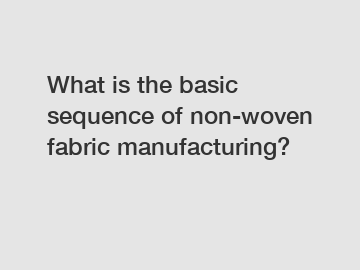What is the basic sequence of non-woven fabric manufacturing?
What is the basic sequence of non-woven fabric manufacturing?
Non-woven fabrics have gained immense popularity in various industries due to their versatility and cost-efficiency. But have you ever wondered about the process behind their manufacturing? In this article, we will explore the basic sequence of non-woven fabric manufacturing, shedding light on the different steps involved in turning raw materials into the final product.
1. Raw Material Preparation:

The first step in non-woven fabric manufacturing is the preparation of raw materials. Depending on the desired properties of the fabric, different types of fibers can be used, including natural fibers like cotton or wool, synthetic fibers like polyester or nylon, or a blend of both. These fibers are either purchased in a pre-processed form or require initial processing such as carding or cleaning to remove impurities and align the fibers.
2. Web Formation:
Once the raw materials are prepared, the next step is to form a web. The web is a flat and porous sheet of fibers that serves as the foundation for the non-woven fabric. Several methods are used to create the web, including dry-laid, wet-laid, or spunbond processes. In the dry-laid process, the fibers are randomly distributed and bonded together using heat, chemicals, or mechanical entanglement. Wet-laid process involves the suspension of fibers in water, which is later drained to create the web. Spunbond process utilizes extruded filaments that are spun onto a conveyor belt to form a continuous web.
3. Bonding:
Once the web is formed, the next crucial step in non-woven fabric manufacturing is bonding. Bonding is necessary to give the fabric strength, integrity, and specific characteristics. There are several bonding methods employed, such as mechanical, chemical, or thermal bonding. Mechanical bonding involves intertwining the fibers through needle punching or hydro entanglement. Chemical bonding is achieved by applying bonding agents that chemically react with the fibers to form a cohesive structure. Thermal bonding, on the other hand, utilizes heat to melt and fuse the fibers together.
4. Finishing:
After bonding, the non-woven fabric requires finishing processes to enhance its properties further. Finishing can involve various treatments like coating, lamination, or dyeing. Coating is done to improve the fabric's performance by adding functionalities such as water repellency, flame resistance, or antimicrobial properties. Lamination involves bonding two or more layers of non-woven fabric together to create a composite fabric with enhanced strength and durability. Dyeing is performed to introduce color or patterns to the fabric, making it visually appealing.
To summarize, the basic sequence of non-woven fabric manufacturing includes raw material preparation, web formation, bonding, and finishing. Each step plays a crucial role in determining the final characteristics and properties of the fabric.
The utilization of non-woven fabrics has expanded beyond conventional applications such as textile manufacturing. These fabrics are now widely used in industries like automotive, healthcare, construction, and filtration. The versatility of non-woven fabrics, along with their cost-effectiveness and eco-friendly nature, has made them a popular choice for various products.
In conclusion, understanding the basic sequence of non-woven fabric manufacturing allows us to appreciate the complexity and ingenuity involved in creating these versatile materials. From raw material preparation to web formation, bonding, and finishing, each step contributes to the final product's quality and functionality. So, the next time you come across a non-woven fabric, you'll have a better appreciation for the intricate process that brings it to life.
Contact us to discuss your requirements of PE Film PE Gowns, type 5 coveralls, disposable sterile utility drape. Our experienced sales team can help you identify the options that best suit your needs.
264
0
0

Comments
All Comments (0)